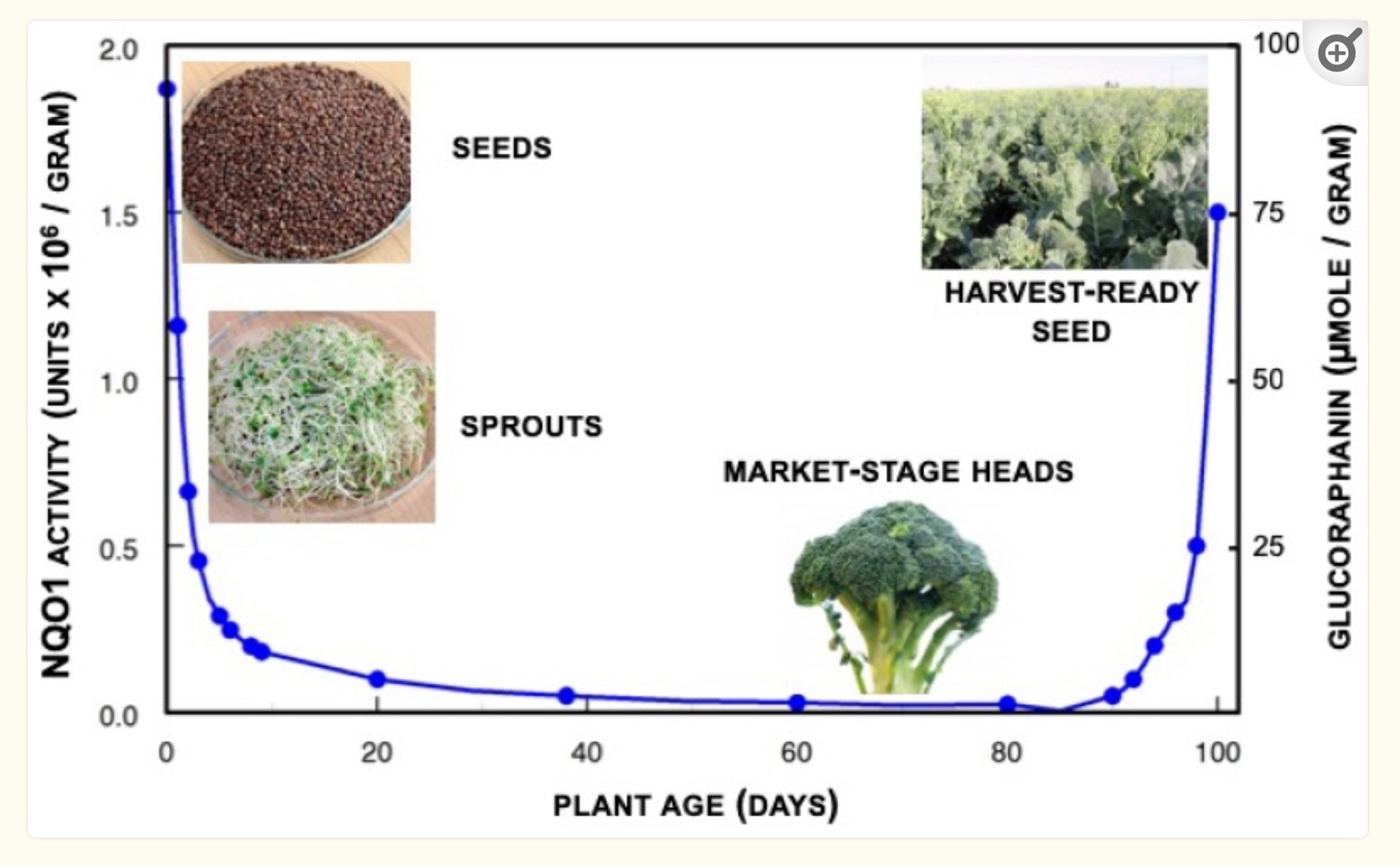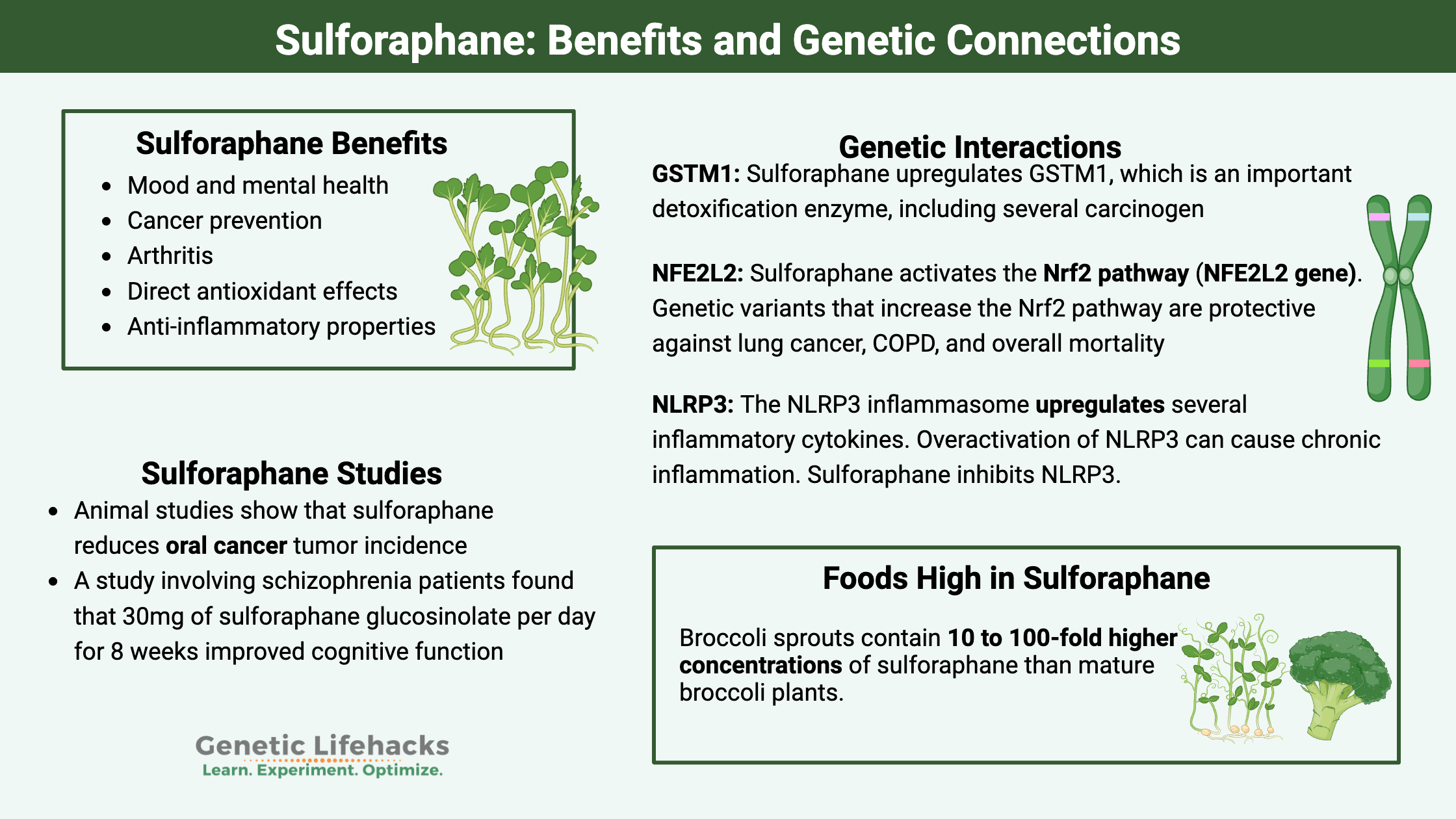Key takeaways:
~ Sulforaphane is a compound derived from broccoli sprouts and other cruciferous vegetables.
~ By activating the Nrf2 pathway, sulforaphane has been shown in clinical trials to help with neuroinflammation, mental health, prostate cancer prevention, asthma, and inflammation.
~ Sulforaphane can be obtained from broccoli sprouts or supplements containing broccoli extract plus myrosinase.
What is sulforaphane?
Sulforaphane is an isothiocyanate compound derived from cruciferous vegetables, particularly broccoli and broccoli sprouts. When cruciferous vegetables are chopped, chewed, or digested, the enzyme myrosinase converts glucoraphanin in the vegetables to sulforaphane.
Sulforaphane was first isolated and written about in 1992 by researchers at Johns Hopkins University.[ref] Since then, sulforaphane has been studied extensively for its potential health benefits, which stem from its antioxidant pathway stimulation and direct anti-inflammatory properties.
History rabbit trail: Broccoli is relatively new in terms of consumption as a vegetable. While historical sources note that it was brought to the UK and then America in the 1700s, it was actually rarely eaten in the US until the 1920s.[ref]
What does sulforaphane do?
Sulforaphane has been shown in studies to impact mood and increase cognitive function by decreasing neuroinflammation. It also may help prevent prostate cancer. For athletes, it may blunt the muscle damage in weight training.
How can one plant-based compound do all that?
Let’s look at the mechanism of action here:
- Nrf2 pathway activation by sulforaphane:
Sulforaphane is a potent activator of the Nrf2 pathway. Nrf2 is a transcription factor that regulates the expression of antioxidant and detoxification enzymes, such as glutathione S-transferases (GSTs), SOD, and catalase. By activating the Nrf2 pathway, sulforaphane enhances the body’s natural defenses against oxidative stress, inflammation, and environmental toxins. For example, the GST enzymes, part of phase II detoxification, are upregulated by the Nrf2 pathway.[ref][ref] - Direct antioxidant effects:
In addition to activating endogenous antioxidants via the Nrf2 pathway, sulforaphane also has some direct antioxidant properties, as it can scavenge free radicals and reactive oxygen species (ROS). In fact, one paper explains that sulforaphane is a stronger antioxidant than ascorbic acid in cell studies.[ref] - Anti-inflammatory properties:
Sulforaphane has been shown to inhibit the nuclear factor-kappa B (NF-κB) pathway, a key regulator of inflammatory responses. By suppressing NF-κB signaling, sulforaphane can reduce the production of pro-inflammatory cytokines and enzymes, such as tumor necrosis factor-alpha (TNF-α), interleukin-1beta (IL-1β), and cyclooxygenase-2 (COX-2). Additionally, sulforaphane decreases the release e of myeloperoxidase and suppresses TNF-α and IL-6.[ref] - Anti-cancer properties:
A number of studies show that sulforaphane inhibits the proliferation of cancer cells. It can induce cell cycle arrest and cell death in cancer cells through modulating cell cycle regulators.[ref][ref][ref] (More on anti-cancer properties in the clinical trial and genotype sections below)
Clinical trials (in humans) using sulforaphane:
While there are a bunch of animal studies on sulforaphane, I’m going to focus here just on the ‘gold stand’ randomized, placebo-controlled clinical trials in humans.
1) Mood and mental health:
Neuroinflammation is believed to be an underlying cause of many mental health disorders. Thus, boosting endogenous antioxidants, such as glutathione, through activation of Nrf2 is thought to be a way to help with mental health problems.
Clinical trials on sulforaphane for schizophrenia show promise. One study found that sulforaphane treatment caused increased brain glutathione levels as shown on brain imaging scans.[ref] A small study involving schizophrenia patients found that 30mg of sulforaphane glucosinolate per day for 8 weeks improved cognitive function a little.[ref]
In autism spectrum disorder, 5 clinical studies have shown positive impacts on autism scores.[ref] To put the positive impact into perspective, I dug deeper into the changes in autism scores. While the change in the “aberrant behavior score” is statistically significant, the improvement isn’t huge.[ref]
Sulforaphane statistically improved depression levels in people with heart disease (a condition likely to involve high ROS).[ref] Another randomized, placebo-controlled trial in older adults also found that sulforaphane improved mood and boosted cognitive function.[ref]
2) Cancer prevention:
A phase II study involving 20 men with recurrent prostate cancer looked at the effect of 200 μmoles/day of sulforaphane-rich extracts < 20 weeks. 8 patients had PSA levels decline, but most did not decline more than 50%.[ref] Another study in men with treated prostate cancer showed that PSA levels were lower in men treated with sulforaphane.[ref]
Animal studies show that sulforaphane reduces oral cancer tumor incidence. A study involving healthy volunteers showed that eating/drinking sulforaphane-rich food increased NQO1 transcription (Nrf2 pathway) in the oral mucosa of two-thirds of the participants.[ref]
3) Stomach inflammation from H. pylori and gastritis:
A study in mice and then in humans showed that broccoli sprout consumption decreases H. pylori and biomarkers of gastric inflammation. The mouse part of the study clearly showed that Nrf2 activation was involved.[ref]
4) Inflammation and muscle damage in athletes:
A randomized, double-blind, placebo-controlled, cross-over trial in healthy young men examined the effects of sulforaphane on markers of muscle damage and inflammation in weight training. The results showed that 30mg/day of sulforaphane for four weeks decreased inflammatory markers and creatine kinase.[ref]
5) Helpful in asthma, but doesn’t cure COPD:
Several studies looked at the effects of sulforaphane supplementation on inflammatory lung diseases. Animal studies show that sulforaphane can reverse allergic asthma.[ref] Animal studies also show that the Nrf2 pathway is critical for preventing pulmonary fibrosis.[ref]
In asthmatics, though, a couple of clinical trials show that sulforaphane may be helpful. Oral sulforaphane as 200g of broccoli sprouts was shown to increase phase II enzyme expression in the upper airways.[ref] Additionally, a study showed reduced bronchoconstriction, and another showed that it reduced allergic response to diesel exhaust particles.[ref][ref]
A parallel, placebo-controlled, phase 2, randomized trial of 25 μmoles or 150 μmoles sulforaphane daily for four weeks showed that it doesn’t cure COPD or affect markers of inflammation.[ref]
6) Arthritis:
It makes sense that upregulating the Nrf2 pathway would decrease inflammation in arthritis. A proof-of-concept clinical trial showed that eating a high sulforaphane (high broccoli) diet for 14 days affected the synovial fluid in arthritic joints. A proteomics analysis showed glucosinolates in the synovial fluid in the high sulforaphane diet group as well as an upregulation of Nrf2.[ref] While this study didn’t show that sulforaphane could reverse arthritis instantly, the fact that sulforaphane reaches the inflamed joint and upregulates Nrf2 which implies that longer-term use of sulforaphane may help reverse the joint inflammation.
Absorption, bioavailability, and sources of sulforaphane:
Let’s look at the details of how we can get sulforaphane and how it will be absorbed and utilized by the body.
First, let’s talk about the conversion into sulforaphane, whether from food or a broccoli extract supplement.
Glucosinolates in broccoli and broccoli sprouts are converted to sulforaphane using the enzyme myrosinase.
Glucosinolates + Myrosinase –> Sulforaphane
Myrosinase is an enzyme released by plant cells when the cells are damaged – e.g. chewing, chopping, or juicing the plants. So chewing or juicing broccoli sprouts gives you both glucosinolates and myrosinase. Similarly, if you are looking at broccoli extract supplements, you want one that contains myrosinase.
Keep in mind: Myrosinase is destroyed by heat, so cooked broccoli contains little to no myrosinase.
Myrosinase is also produced by certain gut bacteria, so the right gut microbiome can increase the conversion of glucosinolates to sulforaphane.[ref] There are large individual differences in the conversion of glucosinolates to sulforaphane. One clinical trial using broccoli sprout juice found that high converters had gut microbes that easily did the conversion. People who had recently taken antibiotics were low converters (as were people who had “mechanical bowel cleansing”, which doesn’t sound pleasant).[ref]
The absorption of sulforaphane (glucosinolates already converted by myrosinase) is fairly high – in the 70-90% range. So once you have sulforaphane in your small intestines, it doesn’t need any help to improve absorption.
The problem with just taking pills containing sulforaphane is that it is not very stable as a supplement. Pure sulforaphane is also very sensitive to temperature and degrades completely within 30 days.[ref] Researchers are working on stabilized formulations of sulforaphane.[ref]
Gut microbes for sulforaphane conversion:
One study looked at the gut microbiome and sulforaphane conversion of 50 individuals consuming broccoli sprouts compared to a control group eating alfalfa sprouts. Looking through the details in the results section of the study, there is a huge individual variation in sulforaphane conversion. People with higher levels of Bifidobacterium, Dorea longicatena, Rominococcus torques, and Roseburia in their gut microbiome had a higher conversion of sulforaphane.[ref]
A study in mice also showed that Bifidobacterium longum helps with the generation of sulforaphane from broccoli sprout extract.[ref] B. longum is commonly found in probiotics, but it is unknown whether it would affect sulforaphane conversion in humans. (Genetic connection: People who are FUT2 non-secretors are often low in Bifido abundance.)
Food sources of sulforaphane:
Broccoli sprouts contain 10 to 100-fold higher concentrations of sulforaphane than mature plants.[ref] Mature broccoli does contain a little bit of glucosinolates that can be converted to sulforaphane, but keep in mind that cooking broccoli reduces the myrosinase. Raw broccoli is a better source of sulforaphane.[ref]
Broccoli seeds are relatively easy to sprout and readily available online. They taste like really strong, sharp broccoli. You could grow them as sprouts or as microgreens — both have similar sulforaphane levels.[ref]
Related article: Bitter genes – why some people don’t taste bitter in broccoli
You can get broccoli seeds in bulk on Amazon or other online sources. To grow sprouts, you need a wide-mouth Mason jar and a sprouting lid (screen mesh lid for a wide-mouth jar).
1 gram of sprouts will give you around 0.425mg of sulforaphane. So for 20 mg of sulforaphane, you would need to consume around 50 g of sprouts.
Younger sprouts have more sulforaphane. Here’s a chart showing the glucoraphanin concentration by plant age:

Increasing the bioavailability of sulforaphane in cooked broccoli:
Adding mustard seeds (ground brown mustard seed) increased the availability of sulforaphane from cooked broccoli by 4-fold.[ref] The study used 1g of powdered mustard seed, which would be about a half teaspoon. If you don’t mind the taste of mustard, this seems like a great way to improve the bioavailability of sulforaphane from cooked broccoli. Or – eat mustard on your sandwich along with a side of broccoli.
Lightly cooking broccoli instead of fully cooking also increases the sulforaphane levels.[ref]
Safety, timing, and dosage of sulforaphane supplements:
As a natural part of cruciferous vegetables, sulforaphane is generally regarded as safe in low doses. At very high injected doses in animal studies, there are negative side effects and signs of toxicity.[ref]
At human doses, side effects can include gastrointestinal upset when eating more cruciferous vegetables than you usually do. A clinical trial involving sulforaphane supplements noted side effects of flatulence, constipation, and diarrhea.[ref]
The clinical trials using sulforaphane can be a bit confusing because some list the amount of sulforaphane and others list broccoli extract amount, which contains more than just sulforaphane.
Keep in mind that broccoli extract supplements will contain other bioactive compounds from broccoli, which may have additional benefits.
Time of day for best results:
Circadian rhythm plays a role in the upregulation of the Nrf2 pathway by sulforaphane. Animal studies show that when circadian rhythm is dysregulated, the levels of Nrf2 and glutathione are lower.[ref]
Nrf2 expression rises and falls over the course of the day. It is most available 3-7 hours after getting up in the morning and is lowest in the evening and at night.[ref] If your goal with supplemental sulforaphane is to increase the Nrf2 activation of antioxidants, then taking the supplement during the middle of the day may be more effective.[ref]
Genetic interactions with sulforaphane:
More on sulforaphane:
Rhonda Patrick has an in-depth video from a few years ago on sulforaphane:
Related articles and topics:

